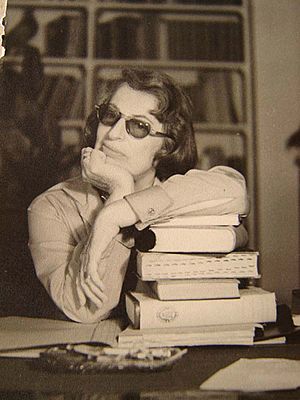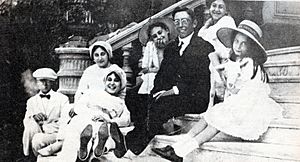Silvina Ocampo facts for kids
Quick facts for kids
Silvina Ocampo
|
|
|---|---|

Ocampo in 1959
|
|
| Born | 28 July 1903 Buenos Aires, Argentina
|
| Died | 14 December 1993 (aged 90) Buenos Aires, Argentina
|
| Resting place | La Recoleta Cemetery, Buenos Aires |
| Occupation |
|
| Spouse(s) | |
| Relatives | Victoria Ocampo (sister) |
Silvina Ocampo (born July 28, 1903 – died December 14, 1993) was an important Argentine writer, poet, and artist. She was known for her short stories and poems. Her friend and fellow writer Jorge Luis Borges once called her "one of the greatest poets in the Spanish language."
Silvina Ocampo's first book was Viaje olvidado (which means Forgotten Journey), published in 1937. Her last work, Las repeticiones, came out after she passed away in 2006. Before becoming a famous writer, Ocampo was a visual artist. She studied painting and drawing in Paris. There, in 1920, she met famous artists like Fernand Léger and Giorgio de Chirico. These artists were important in the surrealism art movement.
Ocampo received many awards for her writing. These included the Municipal Prize for Literature in 1954 and the National Poetry Prize in 1962.
Contents
About Silvina Ocampo's Life
Silvina Ocampo was born into a wealthy family in Buenos Aires, Argentina. She was the youngest of six daughters. Her family had lived in the Canary Islands before moving to Argentina in the mid-1800s. Silvina's older sister, Victoria Ocampo, was also very famous. Victoria started and edited an important Argentine magazine called Sur.
Her Education and Family
Silvina was taught at home by private teachers. She had governesses who taught her French and English. She also had teachers for Spanish and Italian. Because of this, Silvina and her sisters learned to read in English and French before they learned Spanish. Silvina herself said that learning three languages early on helped her writing later in life.
Her family was part of the Argentine upper class. This meant they had a lot of land and were very influential. Many of her ancestors were important figures in Argentine history. For example, one ancestor was a governor, and another was a politician.
In the summer, Silvina's family stayed at a large house in San Isidro. This house, called Villa Ocampo, was very modern for its time. It had electricity and running water. Today, Villa Ocampo is a UNESCO site and a historical monument. Silvina took classes there, which helped her become a writer.
Some experts say that Silvina had a lonely childhood. She spent a lot of time with the people who worked in her family's home. This experience might have influenced her stories, making her write about people who were seen as "different."
Important Moments in Her Youth
Two big events affected Silvina when she was young. One was her sister Victoria's marriage. Silvina felt that Victoria took away her favorite nanny, Fanni, when she got married. This made Silvina feel sad and like her youth was taken away. The other event was the death of her sister Clara. After Clara died, Silvina said she started to dislike social gatherings.
In 1908, Silvina traveled to Europe with her family for the first time. Later, she studied art in Paris with Giorgio de Chirico and Fernand Léger. She also became friends with the Italian writer Italo Calvino. When she returned to Buenos Aires, she continued painting with artists like Norah Borges. She had several art shows.
When her sister Victoria started the Sur magazine in 1931, Silvina was part of the first group of people involved. This magazine published works by many important writers and thinkers.
Marriage and Family Life
In 1934, Silvina met Adolfo Bioy Casares, who would become her husband. They were both Argentine authors. They got married in 1940. Their relationship was sometimes complicated.
Silvina and Adolfo stayed together until her death. In 1954, Adolfo had a daughter named Marta from another relationship. Silvina adopted Marta and raised her as her own child. Sadly, Marta Bioy Ocampo died in a car accident shortly after Silvina passed away.
Silvina Ocampo's Writing Career
Silvina Ocampo started writing short stories in 1936. Her first book of short stories, Viaje olvidado, came out in 1937. After that, she published three books of poetry. She wrote a lot, creating more than 175 stories over 40 years.
Silvina often worked with other writers. She wrote a novel called Los que aman, odian (Those Who Love, Hate) with her husband, Adolfo Bioy Casares, in 1946. She also worked with J. Rodolfo Wilcock on a play called Los Traidores in 1956. With Jorge Luis Borges and Bioy Casares, she helped create two famous collections of stories and poems: Antología de la literatura fantástica (1940) and Antología poética Argentina (1941).
Even though she became a writer, Silvina never stopped her art. She drew pictures for Borges's poems and painted throughout her life. Borges believed her painting helped her poetry. He said her writing had the "immediacy and certainty of the visual image."
Some of Silvina Ocampo's writings that have not been published yet are kept at the University of Notre Dame in the United States.
Her First Books
Silvina's first book of short stories, Viaje olvidado, was published in 1937. Most of the stories in it were very short. Her sister Victoria reviewed the book in Sur magazine. Victoria noted that the stories seemed to be about Silvina's own childhood memories.
Even though Viaje olvidado didn't get great reviews at first, it is now seen as a very important book. It showed readers the unique style and themes that would appear in all her future works. The Sur magazine was very important for Silvina. It helped her connect with Borges, Bioy, and other writers. Many of her first stories, poems, and translations were published in Sur.
In 1942, she published her first two poetry books: Enumeración de la Patria and Espacios métricos. From then on, she wrote both stories and poetry. In 1948, she published Autobiografía de Irene, a collection of stories that showed her writing becoming more skilled.
After publishing several poetry books, she returned to writing stories in 1959 with La furia (The Fury). This book finally brought her more recognition. Many people think La furia is where Ocampo's writing style truly became strong and unique.
Later Works
In the 1960s, Ocampo published fewer books. She released a collection of short stories called Las invitadas (1961) and a poetry book, Lo amargo por dulce (1962). She was more active in the 1970s. During this time, she published poems like Amarillo celeste and Árboles de Buenos Aires. She also wrote a story called Los días de la noche and several children's stories, including El cofre volante and El tobogán.
Her Last Years
Silvina Ocampo's last two books, Y así sucesivamente (1987) and Cornelia frente al espejo (1988), came out as she began to suffer from Alzheimer's disease. This illness slowly made her weaker. She passed away in Buenos Aires on December 14, 1993, at the age of 90. She was buried in the family tomb at La Recoleta Cemetery.
After her death, many of her unpublished writings were released. These included poems and short novels. In 2006, four of her works were published, including Invenciones del recuerdo (an autobiography in verse) and Las repeticiones (a collection of stories). In 2011, a novel she had worked on for many years, La promesa, was finally published.
Themes in Silvina Ocampo's Work
Silvina Ocampo's stories often have a magical or dreamlike quality, similar to her friend Jorge Luis Borges. Experts notice that her writing often explores changes and transformations. These can include characters changing into something else, or parts of a person's identity splitting or changing.
Reflection and Identity
The idea of "reflection" is common in Ocampo's works. This means looking at how things are similar or different, and how one thing can represent another. In her book La furia, she often mentions mirrors, light, glass, and clocks. These objects reflect light and images. Some writers believe that these reflecting objects, like mirrors, show how identity can be changed or copied in Ocampo's fantasy stories. For example, a character might look in a mirror and see something completely different from what's actually there.
Childhood Experiences
Childhood is another common theme in Ocampo's stories. She looks at how people change as they grow older. She also suggests that there can be good things when characters mix traits of children with those of adults. One of her well-known stories about childhood is "El pecado mortal."
Metamorphosis (Changes)
In many of her stories, Ocampo uses physical and mental changes, called metamorphosis, to transform her characters. This can mean people changing into plants, animals, or even machines. For example, in "Sabanas de Tierra," a gardener slowly changes into a plant. In "El rival," a person changes into a feline (cat-like) creature.
Ocampo often shows these changes happening gradually. She describes how a character's senses or actions change. For instance, their hearing, smell, sight, or taste might become different. Some experts connect these transformations to ideas from the Bible, like the idea of returning to dust. In some stories, characters don't have proper names. This might be Ocampo's way of showing that the ideas in the story are meant to be general and apply to everyone.
Silvina Ocampo's Legacy
For a long time, Silvina Ocampo's talent as a writer was sometimes overshadowed. People often focused more on her famous sister Victoria Ocampo, her husband Adolfo Bioy Casares, and her friend Jorge Luis Borges. However, in recent years, more of Ocampo's works have been translated into English. This has helped more people around the world discover and appreciate her amazing writing.
Silvina Ocampo is buried at La Recoleta Cemetery in Buenos Aires.
Selected Works
Short Stories and Novellas
- Viaje olvidado (1937)
- Los que aman, odian (novella with Adolfo Bioy Casares) (1946)
- Autobiografía de Irene (1948)
- La furia (1959)
- Las invitadas (1961)
- Los días de la noche (1970)
- Y así sucesivamente (1987)
- Cornelia frente al espejo (1988)
- Leopoldina's Dream (1988) – a collection of translated stories
- Thus Were Their Faces (2015) – an updated collection of translated stories
- La torre sin fin (novella) (2007)
- La promesa (novella) (2011)
Poetry
- Espacios métricos (1942)
- Enumeración de la patria (1942)
- Los sonetos del jardín (1946)
- Poemas de amor desesperado (1949)
- Los nombres (1953)
- Los traidores (a play in verse) (1956)
- Lo amargo por dulce (1962)
- Amarillo celeste (1972)
- Árboles de Buenos Aires (1979)
- Breve Santoral (1985)
- Silvina Ocampo (2015) – a selection of translated poems
Children's Stories
- El cofre volante (1974)
- El tobogán (1975)
- El caballo alado (1976)
- La naranja maravillosa (1977)
- Canto Escolar (1979)
Anthologies (Collections)
- Antología de la literatura fantástica (1940) – with Borges and Bioy Casares
- Antología poética Argentina (1941) – with Borges and Bioy Casares
- Pequeña antología (1954)
- El pecado mortal (1966)
- Informe del cielo y del infierno (1970)
- La continuación y otras páginas (1981)
- Encuentros con Silvina Ocampo (1982) – dialogues with Noemí Ulla
- Páginas de Silvina Ocampo (1984)
- Las reglas del secreto (1991)
Awards and Honors
- 1945: Municipal Prize for Poetry, for Espacios métricos
- 1953: Second National Poetry Prize, for Los nombres
- 1954: Municipal Prize for Literature
- 1962: National Poetry Prize, for Lo amargo por dulce
- 1988: Club de los 13 Prize, for Cornelia frente al espejo
- 1992: Grand Prize of Honor from SADE (Argentine Writers' Society)
Images for kids
See also
 In Spanish: Silvina Ocampo para niños
In Spanish: Silvina Ocampo para niños



